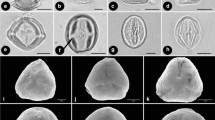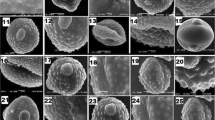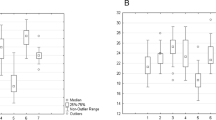Abstract
The pollen morphology of 29 species ofOdontites and related genera was examined by light and scanning electron microscopy. Three major pollen types differing fundamentally in exine sculpturing were found. In the parasitic tribePedicularieae retipilate sculpturing is the most widespread type representing a plesiomorphic character state from which the two other types are derived. Of these, reticulate sculpturing is confined toOdontites, whereas a complex retirugulate pattern was found only in the monotypic Near East genusBornmuellerantha. Within the retipilate and the reticulate major types eight minor types were distinguished based on the differential correlation of exine surface morphology, size, shape and amb form. The pollen data are generally well correlated with macromorphological features and furnish important taxonomic characters at the genus—as well as at the specieslevel.
Similar content being viewed by others
References
Argue, Ch. L., 1980: Pollen morphology in the genusMimulus (Scrophulariaceae) and its taxonomic significance. — Amer. J. Bot.67: 68–87.
—, 1985: Pollen morphology in the generaMonttea andMelosperma (Scrophulariaceae). — Amer. J. Bot.72: 1248–1255.
—, 1986: Pollen morphology ofAmphianthus, Artanema, Curanga, Glossostigma, andPeplidium (Scrophulariaceae-Gratioleae). — Amer. J. Bot.73: 1570–1576.
Barker, W. R., 1986: Biogeography and evolution inEuphrasia (Scrophulariaceae), particularly relating to Australasia. — InBarlow, B. A., (Ed.): Flora and Fauna of Alpine Australasia—ages and origins, pp. 489–510. — Leiden: Brill.
Beauverd, G., 1911: Plantes nouvelles ou critiques de la flore du bassin supérieur du Rhône (Valais, Pays de Gex, Alpes d'Annecy, Maurienne). — Bull. Soc. Bot. Genève, 2. ser.3: 297–339.
Bentham, G., 1876: Genera plantarum 2. — London.
Bolliger, M., 1985: Die Drüsenhaare der GattungOdontites Ludwig (Scrophulariaceae) und ihre systematische Bedeutung. — Bot. Jahrb. Syst.107: 153–175.
Davis, P. H., 1978: Flora of Turkey and the East Aegean Islands 6. — Edinburgh: Edinburgh University Press.
Don, G., 1838: A general system of gardening and botany4 (2). — London.
Erdtman, G., 1947: Suggestions for the classification of fossil and recent pollen grains and spores. — Svensk Bot. Tidskrift41: 104–114.
—, 1952: Pollen morphology and plant taxonomy. Angiosperms. — Stockholm: Almquist & Wiksell.
—, 1969: Handbook of palynology. — New York: Hafner.
Faegri, K., Iversen, J., 1950: Textbook of modern pollen analysis. — Copenhagen: Munksgaard.
—, —, 1975: Textbook of pollen analysis, 3rd edn. — Copenhagen: Munksgaard.
Hartl, D., 1957: Die Stellung vonLindenbergia Lehmann im System der Scrophulariaceen. — Beitr. Biolog. Pflanzen33: 265–278.
—, 1974:Scrophulariaceae. — InHegi, G., (Ed.): Illustrierte Flora von Mitteleuropa, 6/1. — Berlin, Hamburg: Parey.
Hedberg, O. & al., 1979: The yellow-flowered species ofBartsia (Scrophulariaceae) in Tropical Africa. — Norw. J. Bot.26: 1–9.
Inceoğlu, Ö., 1982: Pollen grains in some TurkishRhinantheae (Scrophulariaceae). — Grana21: 83–96.
Kerner, A., 1888: Über die Bestäubungseinrichtungen der Euphrasien. — Verh. Zool. Bot. Ges. Wien38: 563–566.
Kremp, G. O. W., 1965: Morphologic encyclopedia of palynology. — Tucson: University of Arizone Press.
Linnaeus, C., 1753: Species plantarum. II. Stockholm. — Facsimile reprint of the 1st edn. 1959. — London: The Ray Society.
Minkin, J. P., Eshbaugh, W. H., 1989: Pollen morphology of theOrobanchaceae and rhinanthoidScrophulariaceae. — Grana28: 1–18.
Molau, U., 1990: The genusBartsia L. (Scrophulariaceae-Rhinanthoideae). — Opera Botanica, 120 pp. (in press).
Niezgoda, Ch. J., Tomb, A. S., 1975: Systematic palynology of tribeLeucophylleae (Scrophulariaceae) and selectedMyoporaceae. — Pollen & Spores17: 495–516.
Praglowski, J., Punt, W., 1973: An elucidation of the microreticulate structure of the exine. — Grana13: 45–50.
Risch, C., 1939: Die Pollenkörner der in Deutschland wild wachsenden Scrophulariaceen. — Ber. Deutsch. Bot. Ges.57: 108–121.
Rothmaler, W., 1943: Die Aufspaltung vonOdontites Hall. exZinn. — Mitteil. Thüring. Bot. Ver., N.F.,50: 224–230.
Tatzreiter, S., 1985: Präparation von Pollen und Sporen für das Rasterelektronenmikroskop und Lichtmikroskop unter Verwendung von Rhodaniden. — Grana24: 33–43.
Walker, J. W., Doyle, J. A., 1975: The bases of angiosperm phylogeny: palynology. — Ann. Missouri Bot. Gard.62: 664–723.
Watrous, L. E., Wheeler, G. D., 1981: The out-group comparison method of character analysis. — Syst. Zool.30: 1–11.
Webb, D. A., Camarasa, J. M., 1972:Odontites Ludwig. — InTutin, T. G. & al., (Eds.): Flora Europaea 3. — Cambridge: Cambridge University Press.
Author information
Authors and Affiliations
Rights and permissions
About this article
Cite this article
Bolliger, M., Wick, L. The pollen morphology ofOdontites (Scrophulariaceae) and its taxonomic significance. Pl Syst Evol 173, 159–178 (1990). https://doi.org/10.1007/BF00940860
Received:
Revised:
Accepted:
Issue Date:
DOI: https://doi.org/10.1007/BF00940860




